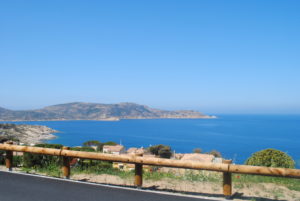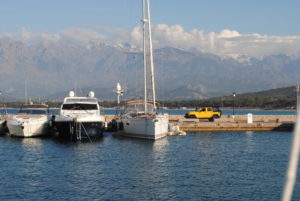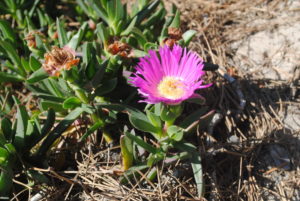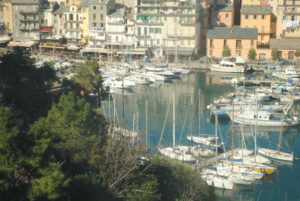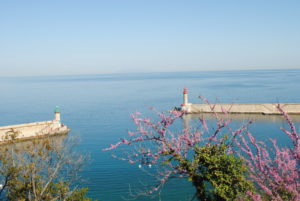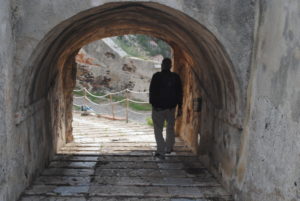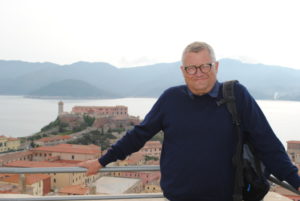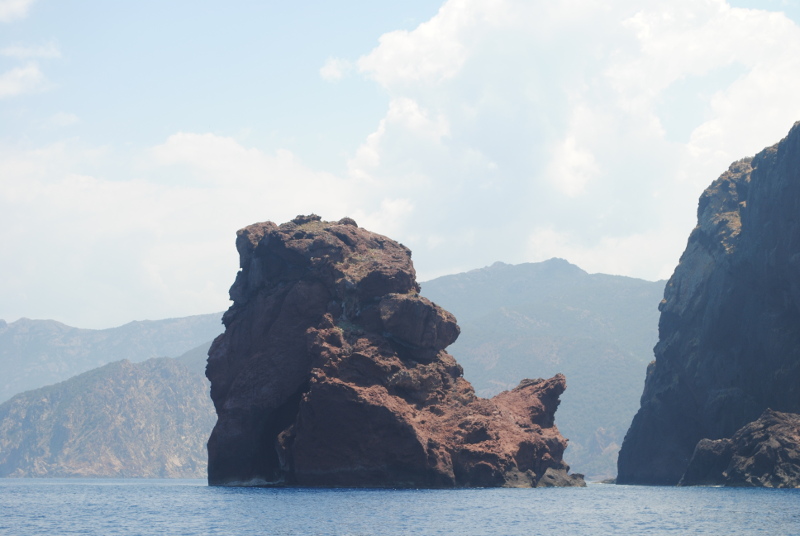
Calvi has become too wild. We must continue
42° 20′ 55.7988” N 8° 36′ 51.5808” E
June 16, 2017
It’s becoming summer in Calvi. It’s mid June, the temperature is buzzing close to 30 degrees, the beachgoers flood the beach, and all over the harbour disco rhythms blast all night in an attempt to whip up an early summer atmosphere.
After having been in Denmark for almost two months, we arrive in a transformed city. Most of the snow is melted on the Corsican mountains, and everywhere Calvi is enjoying more life, than when we left Ronja on a rack at the pickup site, Chantier Navale, at the end of April.
Calvi has become too much for those of us, who enjoy a good night’s sleep. We must continue.
The next stop becomes Girolata, which is not a port but a protected bay with laid out buoys in a pattern resembling a port. You are assigned to a spot by helpful port assistants in inflatable boats that take care of attaching rope to buoys front and rear. We are close to the other boats in an exceptional beautiful landscape with brown dairy cattle on the beach, primitive restauration shacks – all surrounded by beautiful mountains, and after the tour boats have brought the last tourists back to civilization, we are even blessed with a divine silence.
It costs 31 euros for one night. Well, for two buoys and an infinite silence for the hole night. Sometimes that’s worth 31 euros.
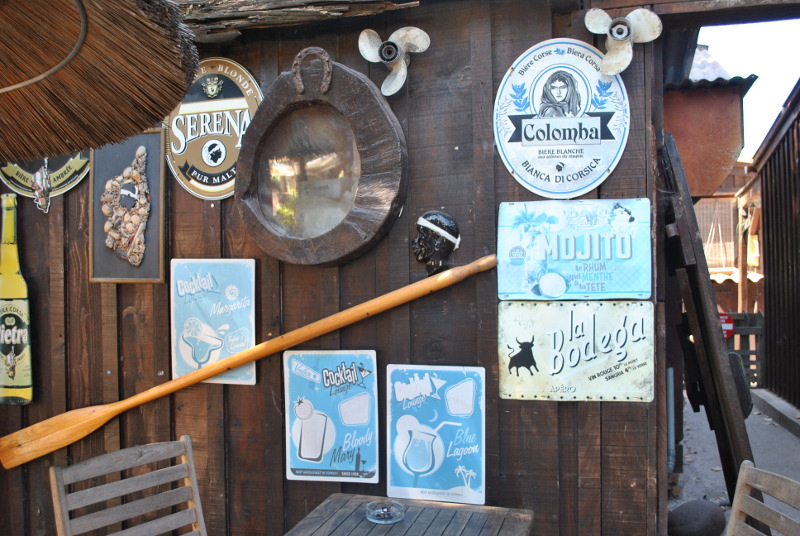
The bars and restaurants at Girolata beach are rather Klondyke-like, with only wooden buildings
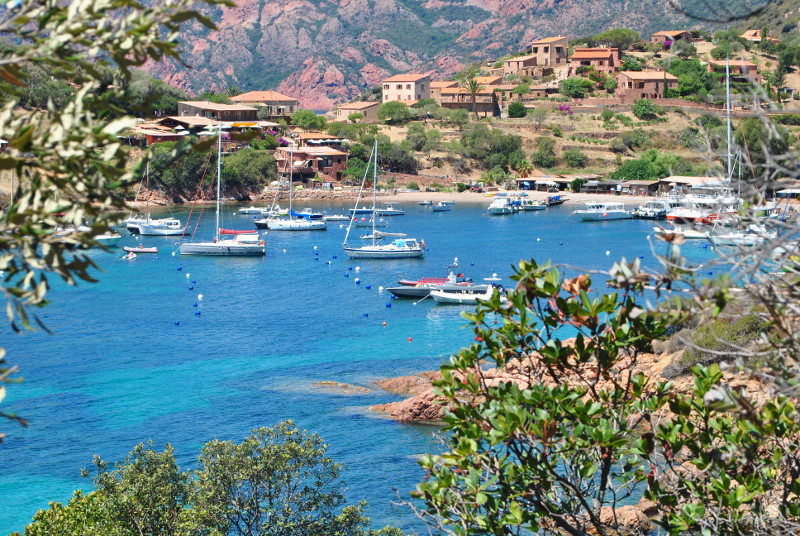
Girolata is actually a small well protected cove inside a larger cove. Buoys are laid out in the pattern of a harbour. Side by side. With a rope fore and aft
We stay for two nights, and we go for walks in the nearby mountains. On Tuesday we continue to Cargése, a small harbour with room for only 12-15 boats in addition to the permanent occupants. Cargése is a Greek-inspired mountain village with Greek Catholic churches. The location is wonderful. But otherwise we are most affected by the fact, that it is less than ideal for shopping. First, you climb a mountain under the burning sun to reach the local Spar supermarket at the top of the mountain, and then you clamber down the mountain again with your stuffed shopping bags.

View from the small town Cargése
Bonus info: Should you ever use a port for some months in Corsica, while you are at home, Calvi is a good bet. Chantier Navale, the local pick up space, stores your boat at an acceptable price, and if you need to have small jobs done on the boat, then Dumé, the practical guy on the spot is more than ordinarily friendly, totally reliable and capable of getting things done. Only “minus” is, that he speaks only French. Great guy.
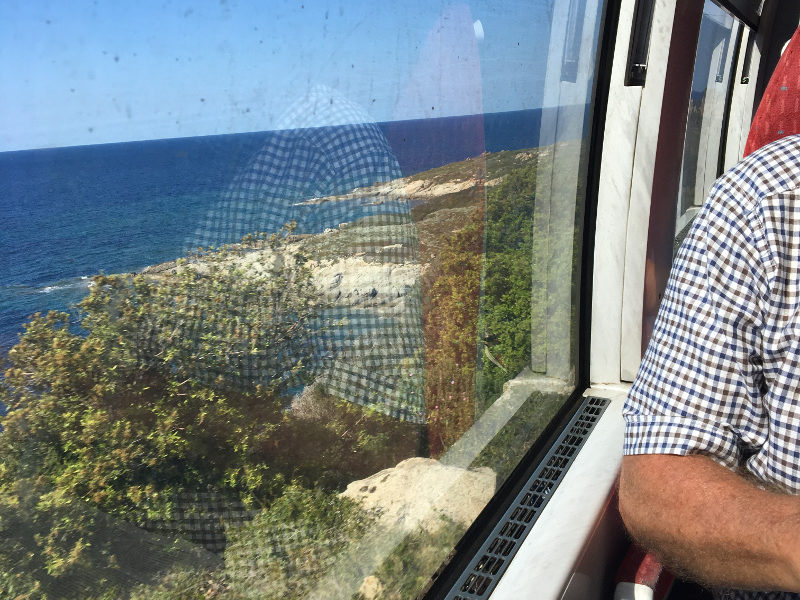
Probably the world’s most beautiful train journey
41° 55′ 9.2244” N 8° 44′ 19.086” E
21- April 23, 2017
When sailors go ashore, they take the train. At least if they go ashore in the city of Calvi in Corsica, and the plane to Denmark is leaving Ajaccio, a little further south in Corsica. By car there is 72 kilometers according to Google Maps. By train the journey lasts five hours. We choose the train.
Many have enthusiastically told us about the small Corsican trains that slide along the coast on narrow shines, creep up the mountains, and make great detours around the mountains to avoid the route beeing to steep.
We are not disappointed. If I was the owner of the railroad, I would order the train windows washed every single day, because a trip with these trains is really a spectacular attraction.
I think such a train journey tells you much of what you need to know about Corsica. About unbelievable beauty in the mountains, about scattered flocks of goats and cows and occasionally – but only rarely – a piece of cultivated soil. The tour brings you through small mountain towns, where you can hardly understand, how the inhabitants can earn a living. Scattered carvrecks and padded mattresses do not seriously obscure the image of Corsica’s overwhelming beauty.
On fallow buildings we see graffiti with slogans of freedom and autonomy for Corsica. We are struggling to understand how an independent Corsica can match the island’s huge unemployment and an annual net cash transfer from mainland France. Corsica currently lives by tourists and not much else.
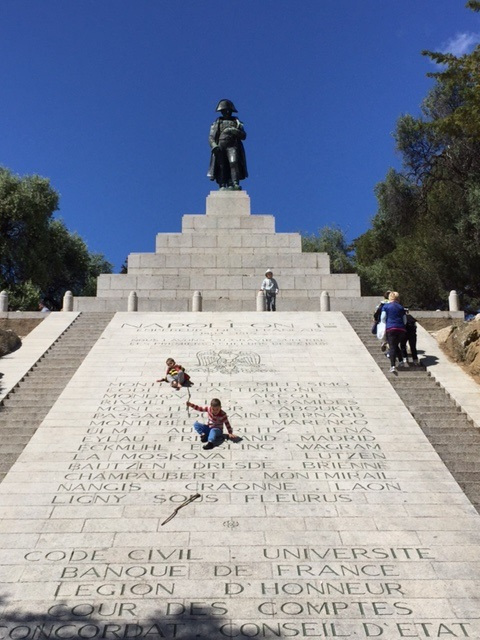
Many french cities claim to have had a special relation to Napoleon Bonaparte. Also Ajaccio where Napoleon was born and lived his first nine years
We have a day and a half in Ajaccio (pronounced asjakio, we are taught) before the flight home. It is a big city after Corsican standards. It may be that people in Bastia think that they are the ones behind the dynamics of the Corsican economy. But it is not thruu. Ajaccio is the island’s capital. It is not particularly beautiful. But it is humming of activity and many visitors. We in particular liked the city’s busy food market and a couple of excellent museums.
Bonus info: Eat at the restaurant Le Roi de Rome. It is rated by TripAdvisor to be the 29th best among 2408 Corsican restaurants. The food is excellent, the owner understands Corsican wine, and the prices are absolutely fair. Also take a trip with the city’s “petit train”. You may feel a little silly sitting a kind of children’s train, but it will take you to places in the area where you would hardly get on foot.
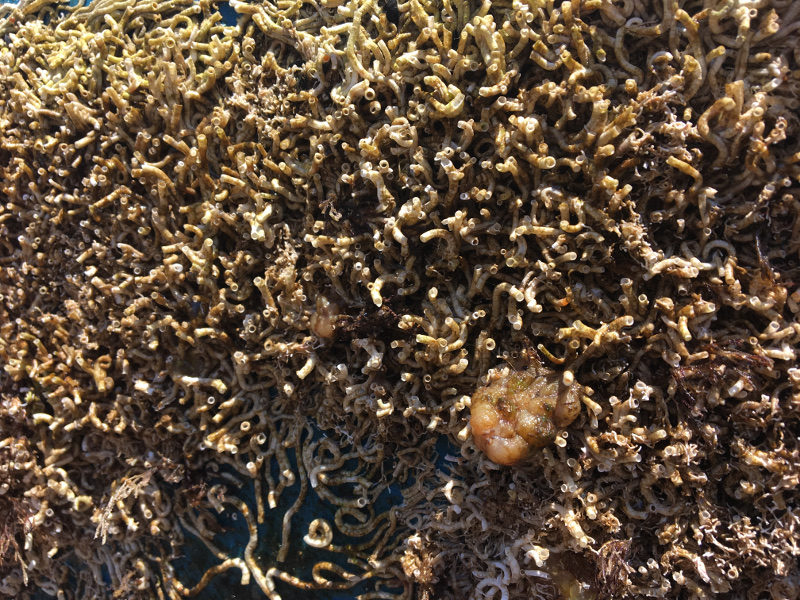
Can you guess what this photo imagines?
42° 33′ 46.6848” N 8° 45′ 25.2” E
21. April 2017
We leave the question on the screen for a moment ….
And here comes the answer: It represents the bottom of a Danish sailboat, which has been in the Mediterranean for more than a year and a half, close to two, without being taken on land, grounded and painted.
Shellfish have found their home especially below the waterline and for some reason especially at the port side of the boat. Further down the hull and on the keel, the boat is surprisingly untouched of its year and a half in the water.
Ronja was last at land in Port St. Louis west of Marseilles. Now we are in Calvi in Corsica. We have agreed with Aire de Carénage de Calvi to pick Ronja out of the water and to take care of her, while we are in Denmark for a couple of months.
Now she is lifted out of the water and stands at an honorable place directly to the bay overlooking beaches and snowy mountain peaks. We feel good about leaving Ronja in the hands of Dumé and his boss Christine. We have talked to them several times, and the way they lift Ronja out of the water, clench her up on a tripod and instantly start cleaning her with high pressure water shows us that they can be their hugs.
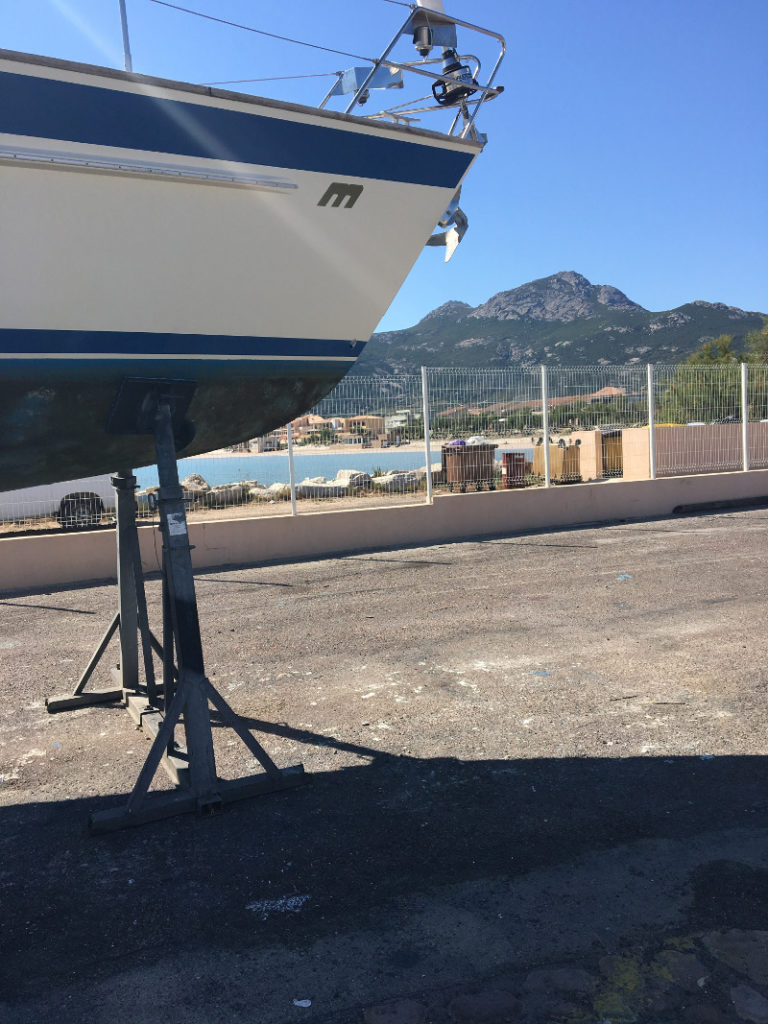
Ronja is now on land in Calvi – with this fantastic wiev
They speak French only, so it’s not easy to agree on the price. We end on agreeing to pay 642 euros for storage (11.32 euros per night), 292 euros for crane lift up and down the water and 604 euros for cleaning and painting the bottom. In addition, the French VAT. Expensive? Well, it might sound expensive. But the alternative storage options would have been significantly more expensive in that part of France at that time of the year, and for us it is a good thing this year to pay someone elseto do the bottom-cleaning and painting on Ronja.
Splendid to be back in Calvi, by the way, after our stormy excursion to Île Rousse. Calvi is definetely our – preliminary – number one among Corsican cities. It has a good size, the port is eminently integrated with the city center, the city has amazing beaches, great restaurants, beautiful buildings and beautiful hiking opportunities. Viva Calvi!
Our enthusiasm for Calvi is shared by others. When we come back from Île Rousse, we retake a berth next to a French 39 feet Beneteau, which we had had as neighbours previously in Calvi. The people onboard are two married couples from Brittany in northern France. For many years they sailed in the area next to Brittany, but they became tired of the tide and the well-known ports. So they acquired a berth in Antibes in the south of France, and since they have from here been exploring the Mediterranean during their holidays. This Easter they are entusiastic about Calvi.
When we waved goodbye to them, they had 40 hours of nonstop sailing to Antibes and then 12 hours drive up through France to reach their home in Brittany.
There are many ways to be a sailor.
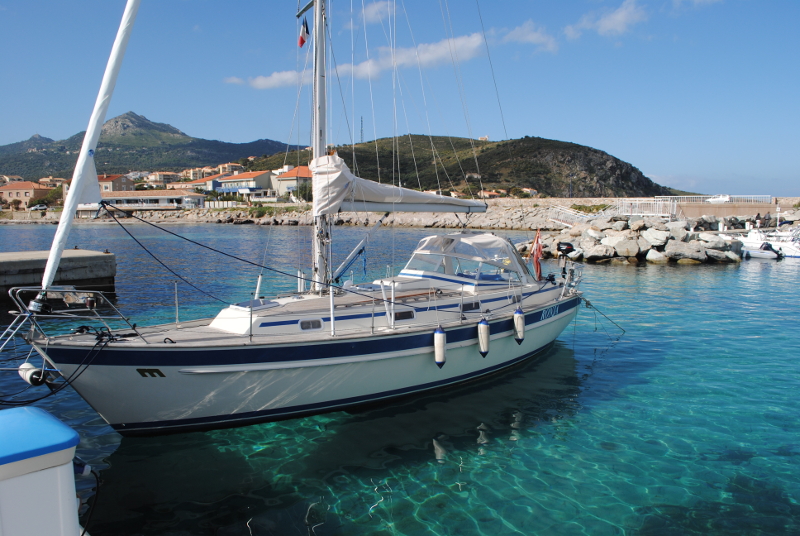
I’le Rousse is not for sailors
42° 38′ 23.028” N 8° 56′ 9.7548” E
17th – 19th of April, 2017
We sailed to I’le Rousse, which we actually passed several days ago on our way to Calvi. Good friends let us know that I’le Rousse is a must-see. It is one of the pearls in northwest Corsica, and if we are to see the city, it must be now before we get too far south.
The arrival of I’le Rousse is a disappointment. The harbour is narrow, badly marked, not very deep, and as we pull up the lines from the buttom of the marina to secure Ronja, it is obvious that these lines have not been used for half a year. Clusters of clams and razor sharp small shellfish cling to the lines and tear our hands to blood.
The outer bassin is a big ferry port. The inner bassin is a small boat marina for small fishinboats and dinghies. Small keelboats like ours do not get any protection here.
We hurry into the city to get balanced our first impression of Île Rousse. There must be something good? There is. Île Rousse turns out to be a charming city. Old men play petanque on the city’s peculiarly oversized square, groups of elderly enjoy a pastiche at the sidewalk cafe, and German tourists throw a beer while studying Lonely Planet and preparing to tension the motorcycle helmet for new experiences.
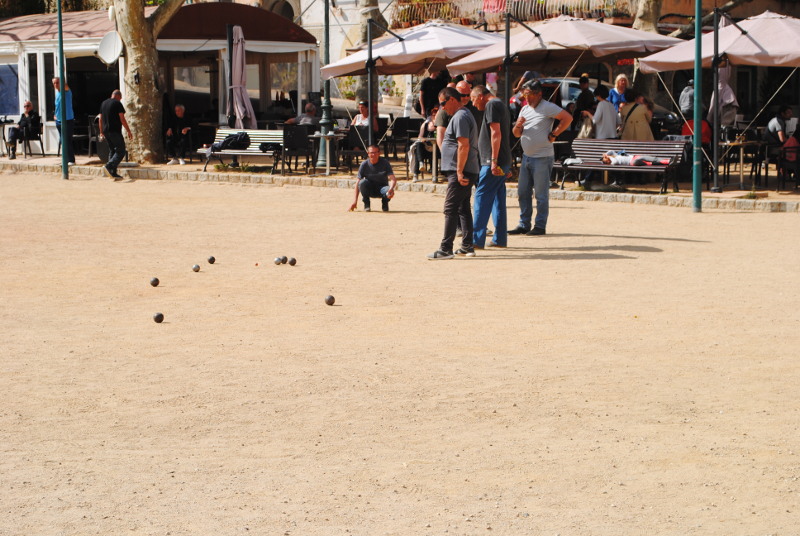
In April, Île Rousse is the Corsicans own town. They characterize the cityscape, set the pace, create the mood. We think that in the summer it is probably the other way around. Then the tourists fill the whole, the many small hotels, the beach restaurants, the white sandy beaches, the many play possibilities on the water in the bay.
The city is easy to overlook. It has a daily food market and good shops. It has a bit of the same as Calvi, just in a smaller version.
Possibly it also has good walking routes along the water, but the tourist office could not enlighten us on this. “Ask in a bookshop,” they told us followed by a: “By the way, bookshops are closed today due to the easter”
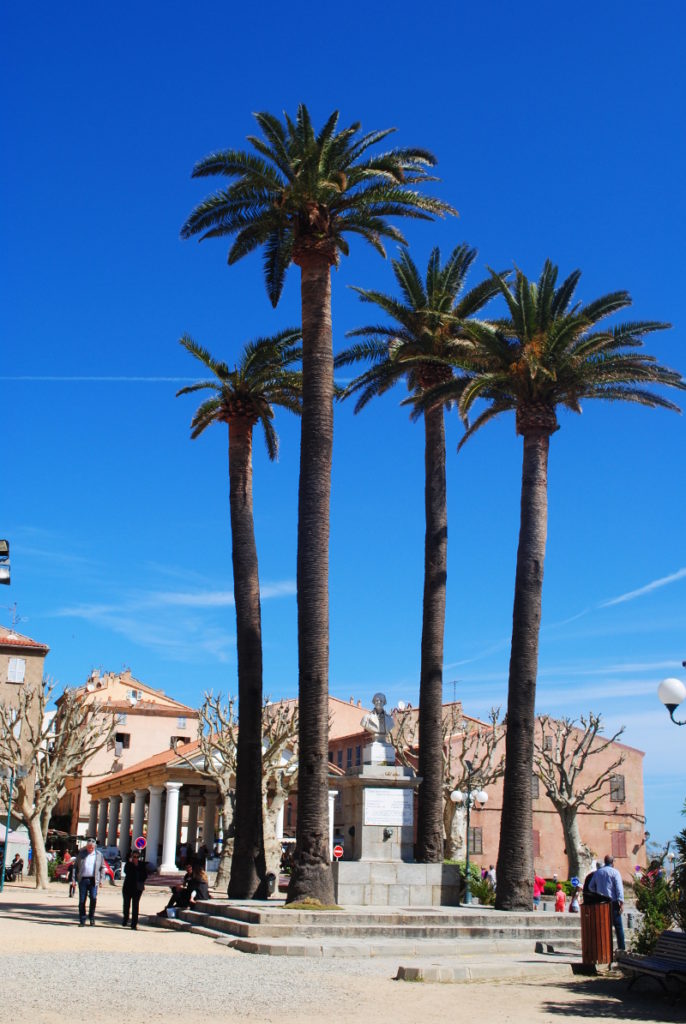
Back in the harbour a storm is getting closer. “It will be at least Beaufort 7“, says the harbour captain. “It’s going to be bad, bad,” he adds. We are his only customer for two days. Others talk about a 40 knot gale, and we convert as usual to our own scale, which says 21 meters pr second from the northwest.
That’s a lot.
The harbour is not built for 21 meters pr second from the northwest. We realised this too late. We did take our precautionary measures. We tightened the aft moorings, we loosened up the bow moorings to keep us away from the quayside, we mounted a fender in Ronja’s bow, we kept distance to the fleets of watercrafts and pedalos that had been pulled into storm safety in the marina.
None of this, however, took into account the ragnarok that came to affect the night. Wild, violent, abrupt pulls in the moorings. Noise and shutterings. No an eye is closed. We try everything to adjust the moorings, and we are awake all night thinking, that Ronja has not deserved this. Poor Ronja
The marina of Île Rousse is a scandal. The worst we have met for several years.
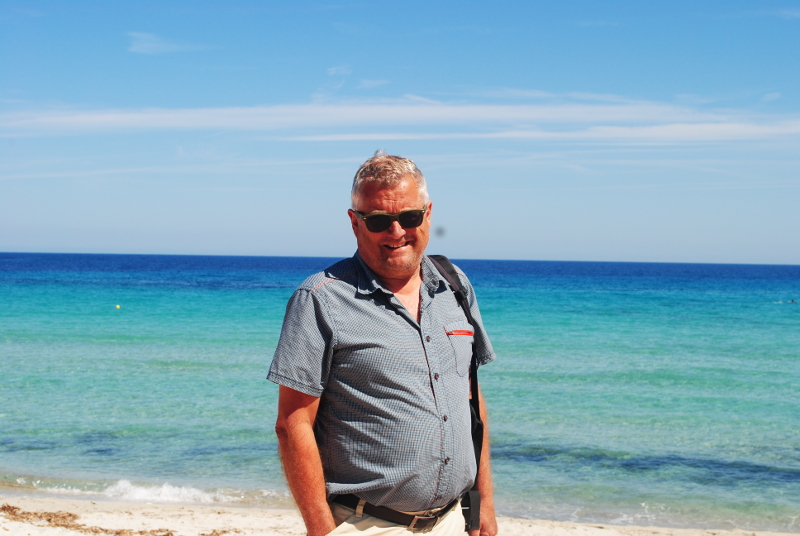
If a weather forecast promises wind from the northwest, keep far away from île Rousse. Sail to Calvi, sail to the mainland, sail anywhere, but avoid île Rousse. The marina is incorrectly constructed. It is a concrete pier, but it is built as a pontoon pier, with large holes in the structure that allow any wave to hammer across the harbor with full strength.
At the same time the marina does not have any qualities of the usual kind – decent showers, toilets, help from the harbour office. Forget that harbor. Sail on. Lovely town. But not for people of the sea.
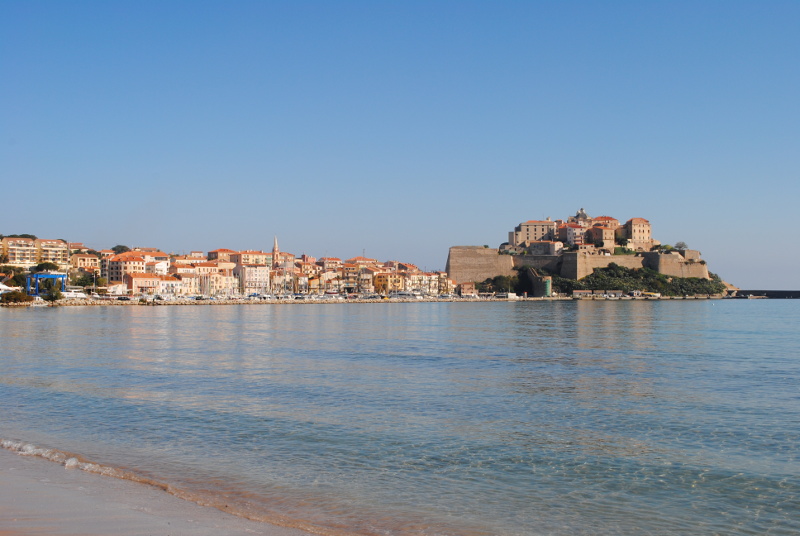
Corsican Calvi has a unique charm
42° 33′ 49.7556” N 8° 45′ 27.3384” E
12-16. April, 2017
If you are in Corsican Calvi on a Good Friday, then you should experience Granitola, the annual Easter parade where barefoot culprits wearing Ku Klux Klan masks carries three relics – a wooden cross, a recumbent sculpture of Jesus Christ and an upright sculpture of the Virgin Mary – down through Calvi city. The parade starts at the cathedral on top of the citadel and winds in long rows down to a church in the city. And then return to the cathedral again.
In front of the procession walks brothers from local churches with banners as they sing the hymns that are linked to the ritual. It is dark, there is a crowd of hundreds, it may seem strange in a the head of a rational nordic person, but you do feel that you witness something big and important.
Calvi is an exciting city. Allready in early April you sense how the city will explode into a true vacation paradise in the summer with its long sandy beaches, beach bars, sunbeds, boat rentals, playgrounds, diving excursions, anchorages and a town center where a good part of yt rises sharply on top of an ancient citadel.
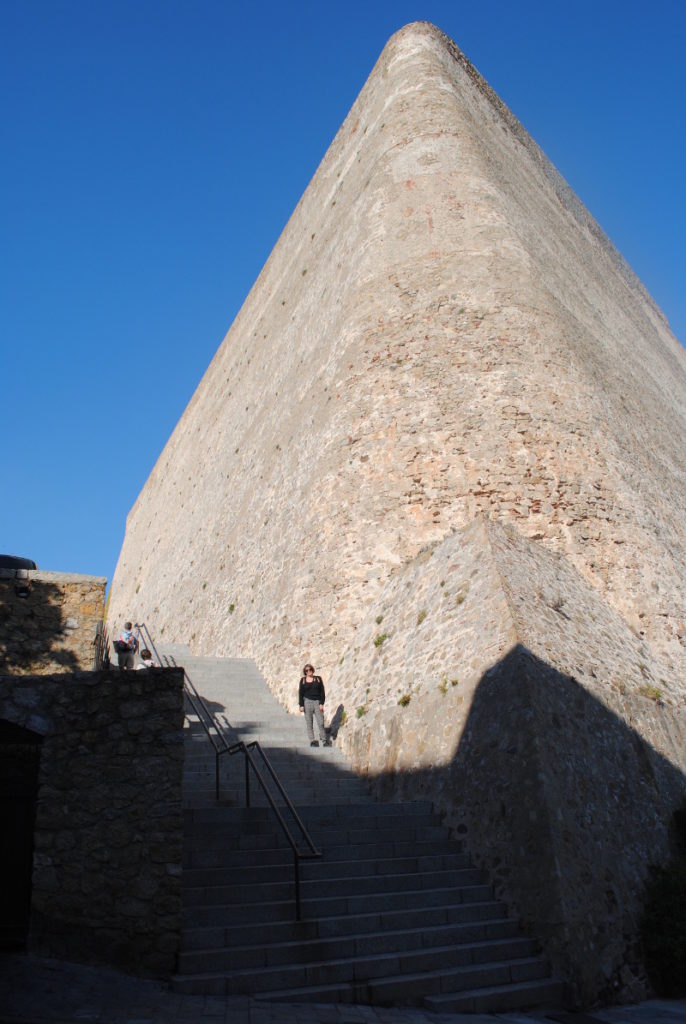
Helen climbing the citadel of Calvi
The city is remarkably rich in shops and restaurants. “On a daily basis we live only 5,000 people in Calvi. But in the summer months increases the number to 45,000, “says a Danish-speaking employee at the tourist office. She is from Amager in DK but lives in Calvi, because her husband works in the Foreign Legion, which has large barracks outside the city.
If the city is overrun in the summer, then is is very accessible here in April. We are only three guesting boats in the harbour and we all get a visit by armed customs officers who want to see the ships documents and hear about our business in Calvi.
Calvi is outstandingly favoured by beautiful scenery. On both sides of the city’s you find bays. One bay has fine sandy beaches and dry, fragrant pine plantations. The other bay has blooming maquis and rocks. Hiking for every taste.
Facts: Calvi takes a high price for a berth in summer. But in low season the price is lowered to 25 euros per night, even with the addition that we can stay for free on Saturday and Sunday, when the port office has closed. “If you are gone by Monday morning at 9:00, then weekends are free,” more than suggests the helpsome girl at the port office.

Tough waters with mirror polished surface
42° 40′ 47.1468” N 9° 17′ 57.2208” E
April 11, 2017
Cap Corse – the northern tip of Corsica – is a waterway that has a reputation of beeing wild and dangerous. We are told, that it can be a tough water, where strong wind gets up out of nowhere and makes the passage between the coast of Corsica and the small island, Île de la Giraglia, difficult.
We see nothing of the sort. The Mediterranean breathes peace with a surface that is close to being mirror. Our Yanmar engine does cope with the work to round Cap Corse. Our only challenge is to avoid the many fishing flags in the area.
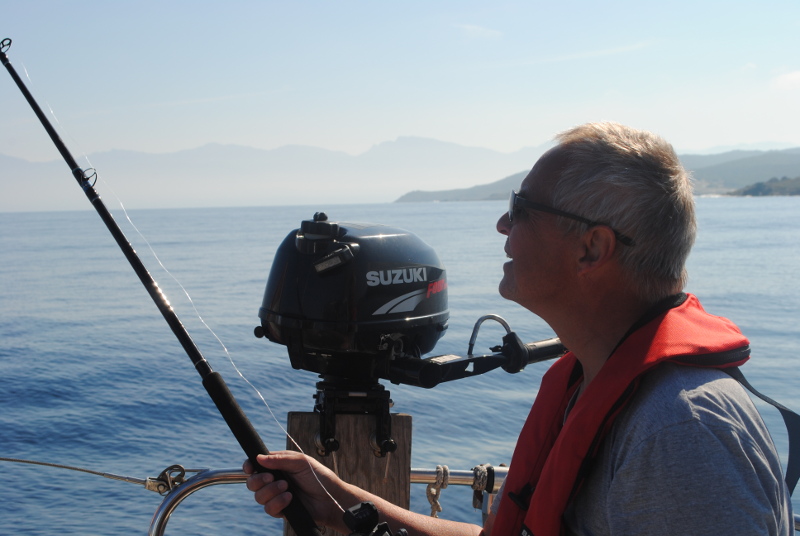
Our goal is St. Florent. A small resort town that in our guidebooks is referred to as a mini version of the more famous resort of Calvi. The comparison does not hold.

St. Florent is well protected at the bottom of a bay. It is a relatively large port, pretty expensive (84 euros for two nights in peak season), a moderate restaurant scene, a dull citadel and a beach that consists of nothing but stones. The city prides itself however that ten kilometers west of the city lies a fantastic sandy beach, Saleccia, who in 1961 was the setting for a movie with Robert Mitchum starring on the allied troops’ invasion of Normandy. “The longest day” was the name of the film.
After two days we leave St. Florent and head for Calvi.
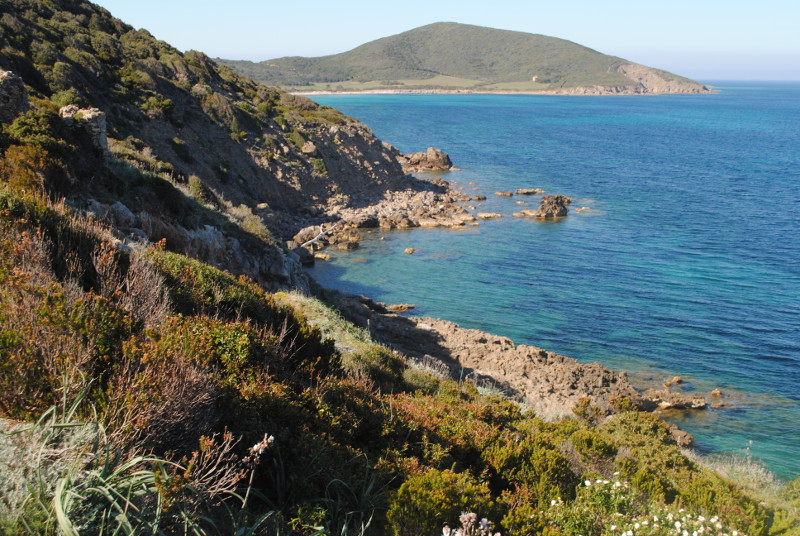
In the footsteps of the customs officers
42° 57′ 32.5404” N 9° 27′ 19.584” E
April 10, 2017
The northern tip of Corsica, Cap Corse, has a very welcoming nature, where the mountains are greener and more gently rounded than the mountains, we can see further into the island. We sail into the small town of Macinaggio (Macinagjhju in Corsican). Since Bastia we have had to friends from Denmark, Helen and Mikkel, onboard Ronja.
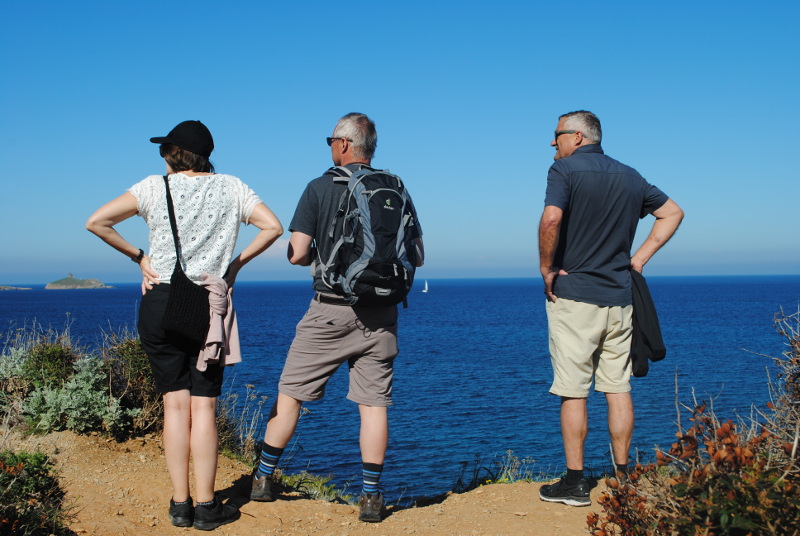
The harbour master has gone on weekend, and however much we would love to pay for our accommodation, we never get a chance to to it.
The town is small, cozy and is obviously depending upon tourists to create life in the 20 restaurants that are all placed along the seafront.
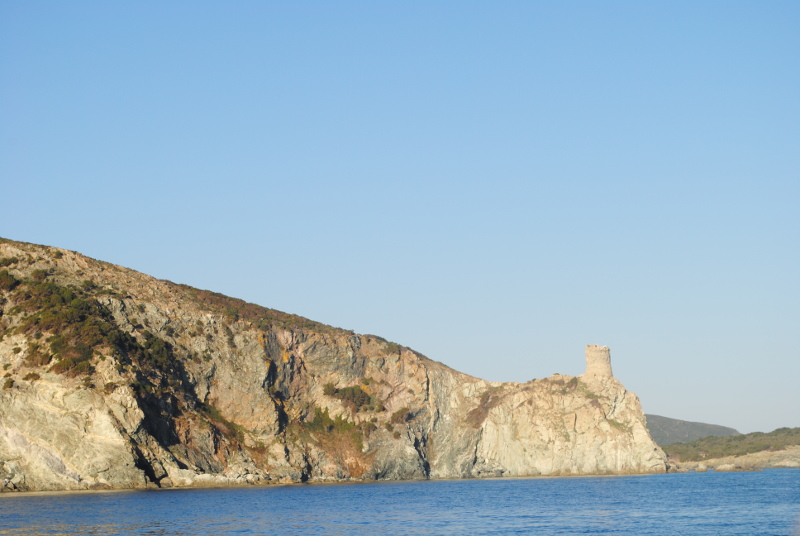
Outside the city, along the coast, it is possible to hike. A narrow path follows the shoreline around among the few cities, and the scenery along the path is matchless. Follow “Sentier des douaniers”, the original path of the customs officers from which they by foot were watching the coast of Corsica.
You can choose between walks in two hours and up to eight hours. Whatever: The tour is fantastic.

Corsica says welcome
42° 41′ 44.4948” N 9° 27′ 3.9024” E
April 7 to 9, 2017
A tired little bird takes a short rest in our cockpit in the middle of the sea between Elba and Corsica, but otherwise today’s 38 nautical miles are rather uneventful, until we just outside the Corsican port city of Bastia is welcomed by three to four dolphins, that swim fast under our boat and make enthusiastic leaps out of the water.
What a welcome.
We sail past the large ferry harbour and slip into the old port. We are assigned an excellent berth for just 73 euros for three nights (yes, we are back in France). The port appears not only to be cheap, it is also exciting. From morning to night there is a busy traffic of fishermen, divers, customs officers, sailing schools and local yachtsmen who slips past the harbour to check the moorings on their boat, now that the season are approaching.
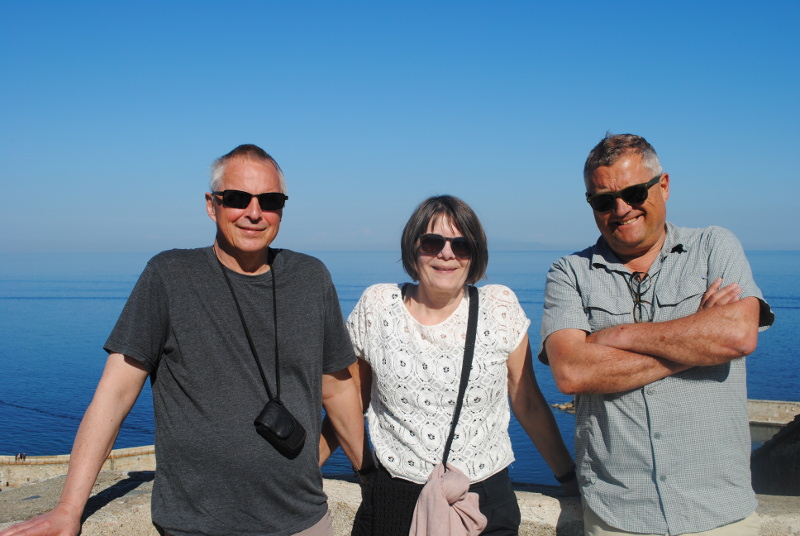
The crew for North- and Northwest Corsica: Skipper (right) and longtime danish friends Mikkel and Helen
We immediately likes the city – especially the area around the old port. The harbour neighborhood is the oldest part of town, and it is obvious Italian inspired and reminiscent in many ways of Genoa with tall buildings and narrow alleys. The town’s citadel is restored and converted into a museum, which is certainly worth a visit.
- Vieux Port. Find Ronja!
- A view from The Citadel
Saturday and Sunday there is a market in Place du Marché, where we buy vegetables, meats, breads, cheeses and herbs. Bastia has 44,000 inhabitants. But when you walk around in it, you get the feeling of a major city.
Bastia has for centuries been in rivalry with Ajaccio about being Corsica’s capital. But Napoleon Bonaparte did not like Bastia, so he made Ajaccio the island’s capital and defeated with an iron fist a rebellion by the inhabitants of Bastia. Since then, the competition between the two cities only have verbal character. The inhabitants of Bastia looks upon Ajaccio as a dusty administrative town, while Bastia in their own perception is the dynamic commercial town that keeps the Corsican economy afloat.
Bonus Info: Taste the Corsican beer made on chestnuts. It is called Pietra (rock), ant it is surprisingly good. Corsica is not known as a beer-country, but in 1996 some people in Bastia began to brew a local beer, which has since become a great succes in Corsica.

Perhaps Napoleon should just have stayed on Elba?
42° 48′ 50.238” N 10° 19′ 46.344” E
Elba is said to be magnificent. Friends and colleagues have for years spoken warmly about the island. Now we’re on the way to experience it ourselves.
Already at the sea long time before we reach Elba, we sense, that it is a lush island even here in early April. In the fresh, crisp spring air Elbas wild profile stands tall. High mountains. And lots of exuberance in green.
We choose to sail to the main town, Portoferraio, passing ferries, cruise ships and fishing boats and sailing into the old inner harbour, Darsena Medicea, which in high season is so coveted that visiting boats can only hope for one night in the harbour. Now it’s April, and we ask immodest for two nights, and in the two days we are in the harbour, we experience no other boats moor.
Portoferraio is a large, majestic and safe harbour. Already the British admiral Nelson thought in 1796 that this was “for its size the most complete harbour in the world.”
No matter where the wind comes from, we are well shielded and have a fine view over the bay.
We spend one day to see Portoferraios fortifications that was grounded in 1548 primarily to protect the city against the dreaded Turkish pirates but was later developed further as part of local wars about dominance in the region.
If you are in Portoferraio, you should visit these fortifications. They are impressive and offers great views over the sea and the city.
We bought a ticket (seven euros for each), and had access to the entire fortification, to Napoleon Bonaparte’s theatre and to the island’s archaeological museum. Museum wise it’s all rather old-fashioned, especially the archaeological museum. Most visitors are foreigners, and yet no texts are translated into English or German, and the exhibited clay pots are presented as unimaginative as arrowheads and flint axes on our own childhood museums. No attempt to tell exciting stories.
The same applies to Napoleon’s residence, the Villa dei Mulini, where he lived during his ten months in exile on Elba. We walk through his rooms, we get told about each piece of furniture and every piece of art on the wall, but we are told nothing about his amazing time on the island, how he launched a modernization of Elba, how he planned his return to the mainland France, and how he with 600 soldiers in a small fleet headed by the brig “Inconstant” slipped past British military vessels around Elba and a few weeks later how he rode into Paris and was hailed as emperor again, because the French loved him more than the reigning royal family. Soon after he met his Waterloo, was beaten by an alliance with England in the lead – and was again exiled, this time to an island far, far out in the Atlantic.
The city’s theatre is a small masterpiece. It is the island’s only theatre, it is cramped, yet five storeys high and it was built on the orders of Napoleon, while he was in exile on the island. He financed it by offering 65 lodges for sale among the richest and most important people in contemporary Elba. Everyone wanted to participate. Every rich person would try to buy the most exclusive lodge to emphasize his or her social status on the island. A remarkable theatre. And in a town with only 12,000 inhabitants.
We leave Elba after two days. But we will return another time. Azurro on the island’s east coast is also said to be an interesting acquaintance.

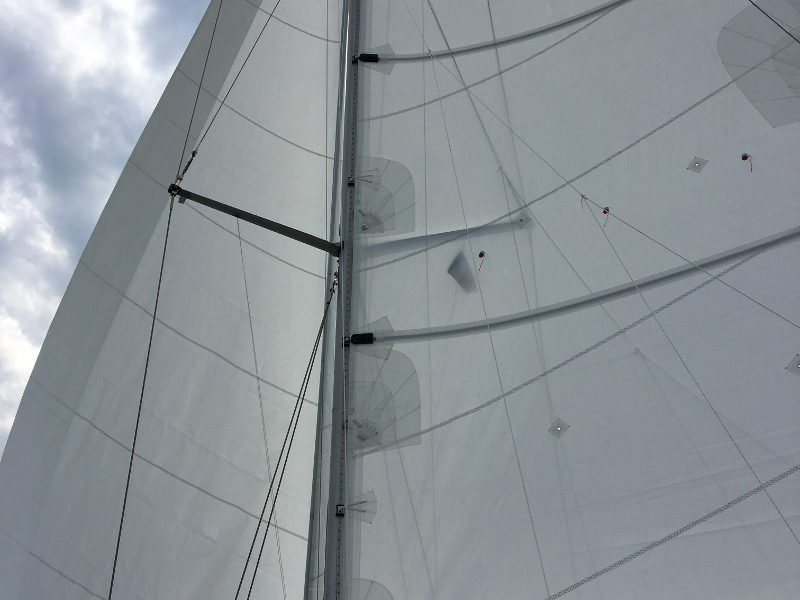
Under brand new sails cruising the Levant – ahead of the spring
43° 6′ 1.188” N 10° 32′ 13.6608” E
April is a wonderful month for sailing in the Mediterranean. You have virtually the sea all to yourself, in the marinas there is always a berth, and the temperature is friendly for northerners like us. A bit chilly at night but mild and sunny during the day. The Italians are still huddled behind winter coats, but danes focus on the fact, that spring is at least one month ahead of Denmark.
The trip from Genoa to Portovenere was 47 nautical miles. Now we take another two days each sailing the same distance. We want to get down to the real goal of this early spring sailing – Elba and Corsica.
The first stretch takes us to Marina di Pisa, one brand new marina near the Arno river mouth. The next stretch takes us to San Vincenco, another brand new port. And from here there is only 20 nautical miles out to Elba.
It gets rather transport-like, when you take distances of 40 or 50 nautical miles each day. You are easily under sail/motor for at least ten hours a day. But we enjoy our new sails, that were delivered in Genoa, and we take turns in the cockpit. One of us is alert, while the other one is off duty for an hour, reading or resting.
Fact: As well Marina di Pisa as San Vincenco are so-called “price band 6-ports”. Yet the first marina take 50 euros for one night, while the latter just 27 euros. The difference is, that Marina di Pisa has decided, the season starts on April 1. Even if there are virtually no sailors in the waters.
